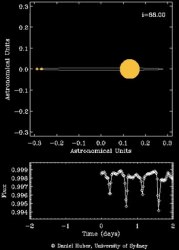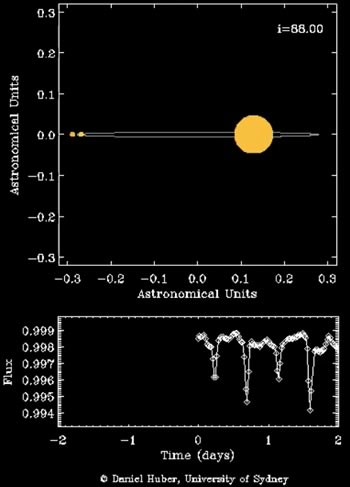[/caption]
It may be visible to the naked eye, but it took the unblinking gaze of NASA’s Kepler space telescope to reveal the true triple nature of this star system.

Unofficially dubbed “Trinity”, object HD 181068 is a multiple star system comprised of three stars: a red giant more than twelve times the diameter of the Sun and two red dwarf stars each slightly smaller than the Sun. The red dwarfs orbit each other in tight rotation around a central point, which in turn orbits the red giant. The smaller stars complete a full orbit around the giant every 45.5 days and, from our point of view, pass directly in front of and behind the huge star.
The orbital eclipse events of HD 181068 last about 2 days. What’s surprising is that during these eclipses the brightness of the system is not affected very much. This is because the surface brightnesses of the three stars are very similar. The current metaphor is a “white rabbit in a snowfall”, wherein the two red dwarfs effectively become invisible when they pass in front of the red giant. It wasn’t until the Kepler mission that we had an observational tool precise enough to detect the structure of this intriguing star system, located 800 light-years away from our own.
“The intriguing nature of this unique system remained unnoticed until now despite the fact that it is nearly bright enough to be visible to the naked eye. We really needed Kepler with its unprecedentedly precise and uninterrupted photometric monitoring to uncover such a rare gem.”
– Aliz Derekas, Eotvos University and Konkoly Observatory, Budapest, Hungary
Another unexpected feature of Trinity is its “quiet” nature. Astronomers have known that red giant stars exhibit seismic oscillations, as does our own Sun. But these oscillations are not present in Trinity’s red giant. Scientists speculate that the two red dwarfs may be creating some sort of gravitational offset, effectively negating the red giant’s vibrations. More research will be needed to determine if this is in fact the case.
Find out more about HD 181068 and other recent Kepler discoveries on NASA’s mission site or in the press release issued by the Ames Research Center, or read the published report on Science.
Image credit: NASA/KASC


There is a similar system dubbed KOI-126, but the inclinations are higher, and the dwarfs eclipse each other only occasionally:
http://www.youtube.com/watch?v=9fowFudwdHQ
Trinity will allow very precise O-C calculations and hopefully detection of orbital element changes caused by tidal interactions in a few years time too.
In systems such as these, would there be any chance that planets would be found? Or would the gravitational effects of the triple suns have forced them out of the system?
Thanks in advance.
The triple star system HD 188753 is speculated to have a “hot Jupiter” planet orbiting the primary star in the system, but no firm confirmation has been made yet; however, in another triple star system, 16 Cygni Bb (see the link via the above link) is a confirmed extrasolar planet orbiting the sun-like star 16 Cygni B, one of two solar mass components of the triple star system 16 Cygni.
I would assume that, while not impossible that planets could form in a system like this, it would definitely be a tricky bit of Newtonian physics to not have them get flung out of the system entirely, what with all them stars whipping about!
Most triple systems are (much) more separated so hot Jupiters have some room to exist around the main star. The 45-day orbital period is the third smallest we know. If it has any planet, it must be far out, I’d say.
so wild. love the video. am trying to imagine a few suns orbiting each other and then both of them around the much larger star. it’s hard to fathom, but fun to try.
You may like this artist’s impression of three suns and a Jupiter-sized planet from the perspective of a hypothetical moon orbiting the planet.
yes i do.
It is said that bunnies may occasionally make good pets.
Reflecting on laclaca’s comment, this seems to be a science toy for tidal interaction studies.
And a good reason to follow up on Kepler’s precision. “Son of Kepler”, soon coming to an orbit close to you. What is it, 400 of these and we would be done with the sky once over? Okay, maybe the concept needs a little work…
I wonder if red dwarfs make good pets…
Could you please allow access to the Animation of HD 181068 through YouTube. Have Quicktime but link does not work. THANKS. IKE
try this link: http://lmgtfy.com/?q=HD+181068
As new satellite telescopes are put in service, there will be new advanceas in astronomy. –the stelar msysrem depicted is astounding